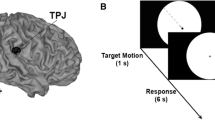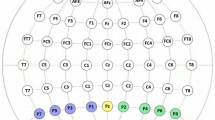Abstract
The functional properties of motion selective areas in human visual cortex, including V3A, MT+, and intraparietal sulcus (IPS) are not fully understood. To examine the functional specialization of these areas for global and local motion processing, we used off-line, neuronavigated, continuous theta burst (cTBS) transcranial magnetic stimulation to temporarily alter neural activity within unilateral V3A, MT+, and IPS. A within-subjects design was employed and stimulation sessions were separated by at least 24 h. In each session, subjects were asked to discriminate the global motion directions of successively presented random dot kinematograms (RDKs) before and after cTBS. RDKs were presented at either 100 or 40 % coherence in either the left or right visual field. We found that V3A stimulation selectively impaired discrimination of 100 % coherent motion, while MT+ stimulation selectively impaired discrimination of 40 % coherent motion. IPS stimulation impaired discrimination of both motion stimuli. All cTBS effects were specific to stimuli presented contralaterally to the stimulation site and vertex stimulation had no effect. The double dissociation between the cTBS effects on MT+ and V3A indicates distinct roles for these two regions in motion processing. Judging the direction of 100 % coherent motion can rely on local motion processing because every dot moves in the same direction. However, judging the global direction of 40 % coherent motion requires global processing. Thus, our results suggest separate, parallel processing of local and global motion in V3A and MT+, respectively, with the outputs of these two areas being combined within the IPS.




Similar content being viewed by others
References
Allen EA, Pasley BN, Duong T, Freeman RD (2007) Transcranial magnetic stimulation elicits coupled neural and hemodynamic consequences. Science 317:1918–1921
Bartels A, Zeki S, Logothetis NK (2008) Natural vision reveals regional specialization to local motion and to contrast-invariant, global flow in the human brain. Cereb Cortex 18:705–717. doi:10.1093/cercor/bhm107
Beckers G, Homberg V (1992) Cerebral visual-motion blindness—transitory akinetopsia induced by transcranial magnetic stimulation of human area V5. Proc R Soc B-Biol Sci 249:173–178
Beckers G, Zeki S (1995) The consequences of inactivating areas V1 and V5 on visual motion perception. Brain 118(Pt 1):49–60
Braddick OJ (1993) Spatial integration along moving contours in competing 1st and 2nd-order motion. Invest Ophthalmol Vis Sci 34:975–975
Braddick OJ, O’Brien JMD, Wattam-Bell J, Atkinson J, Hartley T, Turner R (2001) Brain areas sensitive to coherent visual motion. Perception 30:61–72
Brainard DH (1997) The psychophysics toolbox. Spat Vis 10:433–436
Britten KH, Shadlen MN, Newsome WT, Movshon JA (1993) Responses of neurons in macaque mt to stochastic motion signals. Vis Neurosci 10:1157–1169
Cardin V, Smith AT (2010) Sensitivity of human visual and vestibular cortical regions to egomotion-compatible visual stimulation. Cereb Cortex 20:1964–1973. doi:10.1093/cercor/bhp268
Cornette L, Dupont P, Rosier A et al (1998) Human brain regions involved in direction discrimination. J Neurophysiol 79:2749–2765
Cowey A, Campana G, Walsh V, Vaina LM (2006) The role of human extra-striate visual areas V5/MT and V2/V3 in the perception of the direction of global motion: a transcranial magnetic stimulation study. Exp Brain Res 171:558–562. doi:10.1007/s00221-006-0479-6
Dupont P, Orban GA, De Bruyn B, Verbruggen A, Mortelmans L (1994) Many areas in the human brain respond to visual motion. J Neurophysiol 72:1420–1424
Engel SA, Glover GH, Wandell BA (1997) Retinotopic organization in human visual cortex and the spatial precision of functional MRI. Cereb Cortex 7:181–192
Grefkes C, Fink GR (2005) The functional organization of the intraparietal sulcus in humans and monkeys. J Anat 207:3–17
Hanks TD, Ditterich J, Shadlen MN (2006) Microstimulation of macaque area LIP affects decision-making in a motion discrimination task. Nat Neurosci 9:682–689
Harvey BM, Braddick OJ, Cowey A (2010) Similar effects of repetitive transcranial magnetic stimulation of MT+ and a dorsomedial extrastriate site including V3A on pattern detection and position discrimination of rotating and radial motion patterns. J Vis 10(5):21,1–15
Heekeren HR, Marrett S, Ungerleider LG (2008) The neural systems that mediate human perceptual decision making. Nat Rev Neurosci 9:467–479. doi:10.1038/nrn2374
Helfrich RF, Becker HG, Haarmeier T (2013) Processing of coherent visual motion in topographically organized visual areas in human cerebral cortex. Brain Topogr 26:247–263. doi:10.1007/s10548-012-0226-1
Ho TC, Brown S, Serences JT (2009) Domain general mechanisms of perceptual decision making in human cortex. J Neurosci 29:8675–8687
Hotson J, Braun D, Herzberg W, Boman D (1994) Transcranial magnetic stimulation of extrastriate cortex degrades human motion direction discrimination. Vision Res 34:2115–2123
Huang YZ, Edwards MJ, Rounis E, Bhatia KP, Rothwell JC (2005) Theta burst stimulation of the human motor cortex. Neuron 45:201–206
Huk AC, Ress D, Heeger DJ (2001) Neuronal basis of the motion aftereffect reconsidered. Neuron 32:161–172
Kamitani Y, Tong F (2006) Decoding seen and attended motion directions from activity in the human visual cortex. Curr Biol 16:1096–1102. doi:10.1016/j.cub.2006.04.003
Kayser AS, Erickson DT, Buchsbaum BR, D’Esposito M (2010) Neural representations of relevant and irrelevant features in perceptual decision making. J Neurosci 30:15778–15789
Konen CS, Kastner S (2008) Representation of eye movements and stimulus motion in topographically organized areas of human posterior parietal cortex. J Neurosci 28:8361–8375. doi:10.1523/JNEUROSCI.1930-08.2008
Lewis JW, Van Essen DC (2000) Corticocortical connections of visual, sensorimotor, and multimodal processing areas in the parietal lobe of the macaque monkey. J Comp Neurol 428:112–137
McKeefry DJ, Watson JDG, Frackowiak RSJ, Fong K, Zeki S (1997) The activity in human areas V1/V2, V3, and V5 during the perception of coherent and incoherent motion. Neuroimage 5:1–12
McKeefry DJ, Burton MP, Vakrou C, Barrett BT, Morland AB (2008) Induced deficits in speed perception by transcranial magnetic stimulation of human cortical areas V5/MT+ and V3A. J Neurosci 28:6848–6857
Moutoussis K, Keliris G, Kourtzi Z, Logothetis N (2005) A binocular rivalry study of motion perception in the human brain. Vision Res 45:2231–2243. doi:10.1016/j.visres.2005.02.007
Nakamura H, Kuroda T, Wakita M et al (2001) From three-dimensional space vision to prehensile hand movements: the lateral intraparietal area links the area V3A and the anterior intraparietal area in macaques. J Neurosci 21:8174–8187
Newsome WT, Pare EB (1988) A selective impairment of motion perception following lesions of the middle temporal visual area (Mt). J Neurosci 8:2201–2211
Orban GA, Fize D, Peuskens H et al (2003) Similarities and differences in motion processing between the human and macaque brain: evidence from fMRI. Neuropsychologia 41:1757–1768
Orban GA, Van Essen D, Vanduffel W (2004) Comparative mapping of higher visual areas in monkeys and humans. Trends Cogn Sci 8:315–324
Pascual-Leone A, Walsh V, Rothwell J (2000) Transcranial magnetic stimulation in cognitive neuroscience–virtual lesion, chronometry, and functional connectivity. Curr Opin Neurobiol 10:232–237
Pelli DG (1997) The VideoToolbox software for visual psychophysics: transforming numbers into movies. Spat Vis 10:437–442
Rees G, Friston K, Koch C (2000) A direct quantitative relationship between the functional properties of human and macaque V5. Nat Neurosci 3:716–723
Rizzo M, Nawrot M, Zihl J (1995) Motion and shape perception in cerebral akinetopsia. Brain 118(Pt 5):1105–1127
Rust NC, Mante V, Simoncelli EP, Movshon JA (2006) How MT cells analyze the motion of visual patterns. Nat Neurosci 9:1421–1431
Salzman CD, Britten KH, Newsome WT (1990) Cortical microstimulation influences perceptual judgments of motion direction. Nature 346:174–177
Scase MO, Braddick OJ, Raymond JE (1996) What is noise for the motion system? Vision Res 36:2579–2586
Serences JT, Saproo S, Scolari M, Ho T, Muftuler LT (2009) Estimating the influence of attention on population codes in human visual cortex using voxel-based tuning functions. Neuroimage 44:223–231. doi:10.1016/j.neuroimage.2008.07.043
Sereno MI, Dale AM, Reppas JB et al (1995) Borders of multiple visual areas in humans revealed by functional magnetic-resonance-imaging. Science 268:889–893
Sereno M, Pitzalis S, Martinez A (2001) Mapping of contralateral space in retinotopic coordinates by a parietal cortical area in humans. Science 294:1350–1354
Shipp S, de Jong BM, Zihl J, Frackowiak RS, Zeki S (1994) The brain activity related to residual motion vision in a patient with bilateral lesions of V5. Brain 117(Pt 5):1023–1038
Silver MA, Kastner S (2009) Topographic maps in human frontal and parietal cortex. Trends Cogn Sci 13:488–495
Smith AT, Greenlee MW, Singh KD, Kraemer FM, Hennig J (1998) The processing of first- and second-order motion in human visual cortex assessed by functional magnetic resonance imaging (fMRI). J Neurosci 18:3816–3830
Sunaert S, Van Hecke P, Marchal G, Orban GA (1999) Motion-responsive regions of the human brain. Exp Brain Res 127:355–370
Swisher JD, Halko MA, Merabet LB, McMains SA, Somers DC (2007) Visual topography of human intraparietal sulcus. J Neurosci 27:5326–5337. doi:10.1523/JNEUROSCI.0991-07.2007
Tarnutzer AA, Lasker AG, Zee DS (2013) Continuous theta-burst stimulation of the right superior temporal gyrus impairs self-motion perception. Exp Brain Res 230:359–370
Thompson B, Aaen-Stockdale C, Koski L, Hess RF (2009) A double dissociation between striate and extrastriate visual cortex for pattern motion perception revealed using rTMS. Hum Brain Mapp 30:3115–3126
Tootell RBH, Reppas JB, Kwong KK et al (1995) Functional-analysis of human mt and related visual cortical areas using magnetic-resonance-imaging. J Neurosci 15:3215–3230
Tootell RBH, Mendola JD, Hadjikhani NK et al (1997) Functional analysis of V3A and related areas in human visual cortex. J Neurosci 17:7060–7078
Tosoni A, Galati G, Romani GL, Corbetta M (2008) Sensory-motor mechanisms in human parietal cortex underlie arbitrary visual decisions. Nat Neurosci 11:1446-1453. http://www.nature.com/neuro/journal/v11/n12/suppinfo/nn.2221_S1.html
Vaina LM, Gryzwacz NM, Saiviroonporn P, LeMay M, Bienfang DC, Cowey A (2003) Can spatial and temporal motion integration compensate for deficits in local motion mechanisms? Neuropsychologia 41:1817–1836
Vaina LM, Cowey A, Jakab M, Kikinis R (2005) Deficits of motion integration and segregation in patients with unilateral extrastriate lesions. Brain 128:2134–2145
van Kemenade BM, Muggleton N, Walsh V, Saygin AP (2012a) Effects of TMS over premotor and superior temporal cortices on biological motion perception. J Cogn Neurosci 24:896–904
van Kemenade BM, Muggleton N, Walsh V, Saygin AP (2012b) Effects of TMS over premotor and superior temporal cortices on biological motion perception. J Cogn Neurosci 24:896–904. doi:10.1162/jocn_a_00194
Wandell BA, Dumoulin SO, Brewer AA (2007) Visual field maps in human cortex. Neuron 56:366–383
Watson AB, Pelli DG (1983) Quest—a Bayesian adaptive psychometric method. Percept Psychophys 33:113–120
Acknowledgments
This work was supported by the China Postdoctoral Science Foundation (2013T60011), the Ministry of Science and Technology of China (2011CBA00400 and 2013CB531304), and the National Natural Science Foundation of China (Project 31230029, 31421003, 91132302 and 90820307).
Author information
Authors and Affiliations
Corresponding author
Additional information
Peng Cai and Nihong Chen have contributed equally to this work.
Rights and permissions
About this article
Cite this article
Cai, P., Chen, N., Zhou, T. et al. Global versus local: double dissociation between MT+ and V3A in motion processing revealed using continuous theta burst transcranial magnetic stimulation. Exp Brain Res 232, 4035–4041 (2014). https://doi.org/10.1007/s00221-014-4084-9
Received:
Accepted:
Published:
Issue Date:
DOI: https://doi.org/10.1007/s00221-014-4084-9




